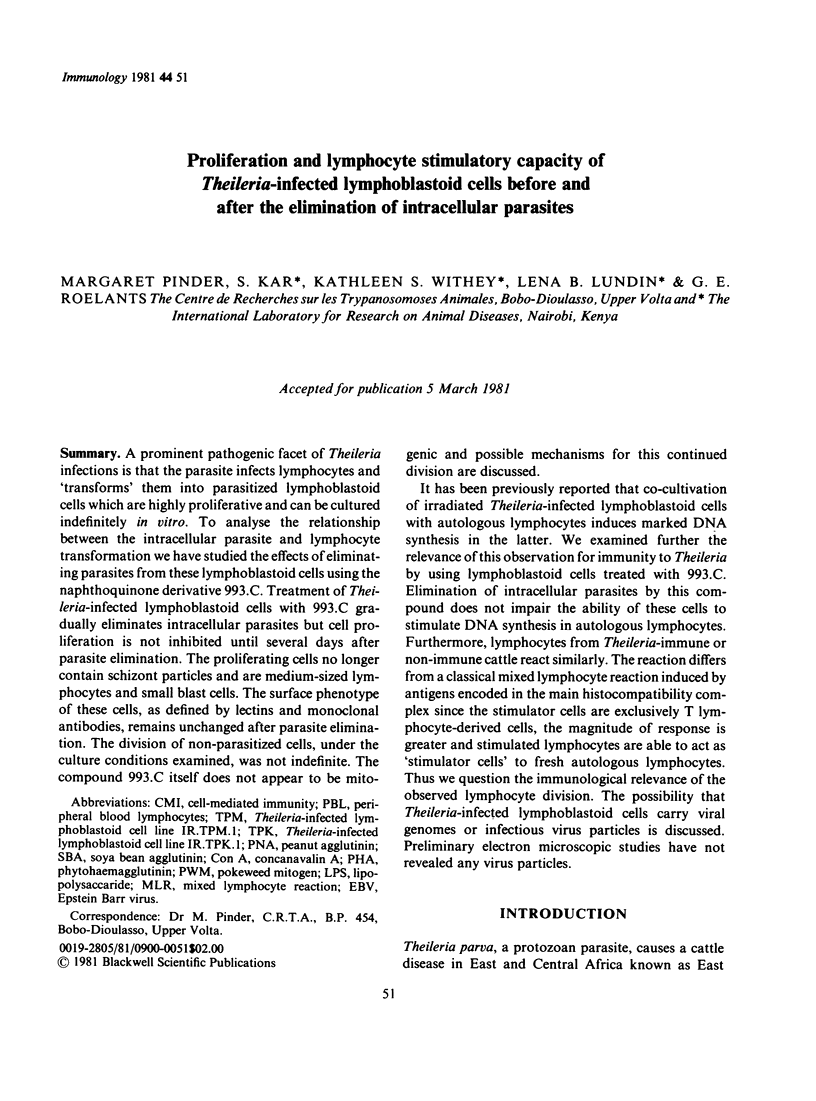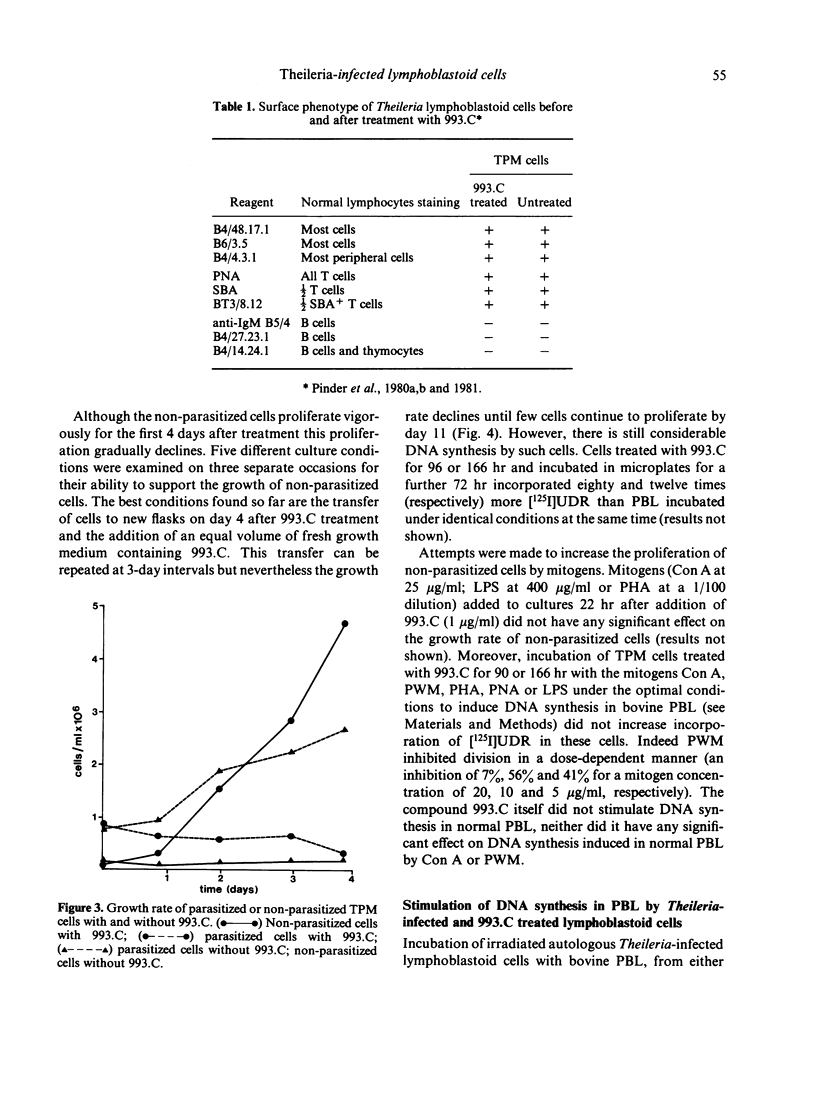Abstract
A prominent pathogenic facet of Theileria infections is that the parasite infects lymphocytes and 'transforms' them into parasitized lymphoblastoid cells which are highly proliferative and can be cultured indefinitely in vitro. To analyse the relationship between the intracellular parasite and lymphocyte transformation we have studied the effects of eliminating parasites from these lymphoblastoid cells using the naphthoquinone derivative 993.C. Treatment of Theileria-infected lymphoblastoid cells with 993.C gradually eliminates intracellular parasites but cell proliferation is not inhibited until several days after parasite elimination. The proliferating cells no longer contain schizont particles and are medium-sized lymphocytes and small blast cells. The surface phenotype of these cells, as defined by lectins and monoclonal antibodies, remains unchanged after parasite elimination. The division of non-parasitized cells, under the culture conditions examined, was not indefinite. The compound 993.C itself does not appear to be mitogenic and possible mechanisms for this continued division are discussed. It has been previously reported that co-cultivation of irradiated Theileria-infected lymphoblastoid cells with autologous lymphocytes induces marked DNA synthesis in the latter. We examined further the relevance of this observation for immunity to Theileria by using lymphoblastoid cells treated with 993.C. Elimination of intracellular parasites by this compound does not impair the ability of these cells to stimulate DNA synthesis in autologous lymphocytes. Furthermore, lymphocytes from Theileria-immune or non-immune cattle react similarly. The reaction differs from a classical mixed lymphocyte reaction induced by antigens encoded in the main histocompatibility complex since the stimulator cells are exclusively T lymphocyte-derived cells, the magnitude of response is greater and stimulated lymphocytes are able to act as 'stimulator cells' to fresh autologous lymphocytes. Thus we question the immunological relevance of the observed lymphocyte division. The possibility that Theileria-infected lymphoblastoid cells carry viral genomes or infectious virus particles is discussed. Preliminary electron microscopic studies have not revealed any virus particles.
Full text
PDF









Selected References
These references are in PubMed. This may not be the complete list of references from this article.
- Bausher J. C., Smith R. T. Studies of the Epstein-Barr virus-host relationship: autochthonous and allogeneic lymphocyte stimulation by lymphoblast cell lines in mixed cell culture. Clin Immunol Immunopathol. 1973 Jan;1(2):270–281. doi: 10.1016/0090-1229(73)90027-5. [DOI] [PubMed] [Google Scholar]
- Brown C. G., Cunningham M. P., Joyner L. P., Purnell R. E., Branagan D., Corry G. L., Bailey K. P. Theileria parva: significance of leukocytes for infecting cattle. Exp Parasitol. 1978 Jun;45(1):55–64. doi: 10.1016/0014-4894(78)90044-9. [DOI] [PubMed] [Google Scholar]
- Brown C. G., Stagg D. A., Purnell R. E., Kanhai G. K., Payne R. C. Letter: Infection and transformation of bovine lymphoid cells in vitro by infective particles of Theileria parva. Nature. 1973 Sep 14;245(5420):101–103. doi: 10.1038/245101a0. [DOI] [PubMed] [Google Scholar]
- Cole L. J., Nowell P. C. Parental-F1 hybrid bone marrow chimeras: high incidence of donor-type lymphomas. Proc Soc Exp Biol Med. 1970 Jul;134(3):653–657. doi: 10.3181/00379727-134-34854. [DOI] [PubMed] [Google Scholar]
- Emery D. L., Morrison W. I. Generation of autologous mixed leucocyte reactions during the course of infection with Theileria parva (East Coast Fever) in cattle. Immunology. 1980 Jun;40(2):229–237. [PMC free article] [PubMed] [Google Scholar]
- Fathman C. G., Weissman I. L. Production of alloreactive T-cell lymphomas. Nature. 1980 Jan 24;283(5745):404–406. doi: 10.1038/283404a0. [DOI] [PubMed] [Google Scholar]
- McHardy N. In vitro studies on the action of menoctone and other compounds on Theileria parva and T. annulata. Ann Trop Med Parasitol. 1978 Dec;72(6):501–511. doi: 10.1080/00034983.1978.11719354. [DOI] [PubMed] [Google Scholar]
- Pearson T. W., Lundin L. B., Dolan T. T., Stagg D. A. Cell-mediated immunity to Theileria-transformed cell lines. Nature. 1979 Oct 25;281(5733):678–680. doi: 10.1038/281678a0. [DOI] [PubMed] [Google Scholar]
- Pearson T. W., Roelants G. E., Lundin L. B., Mayor-Withey K. S. The bovine lymphoid system: binding and stimulation of peripheral blood lymphocytes by lectins. J Immunol Methods. 1979;26(3):271–282. doi: 10.1016/0022-1759(79)90252-7. [DOI] [PubMed] [Google Scholar]
- Pinder M., Hewett R. S. Monoclonal antibodies detect antigenic diversity in Theileria parva parasites. J Immunol. 1980 Feb;124(2):1000–1001. [PubMed] [Google Scholar]
- Pinder M., Musoke A. J., Morrison W. I., Roelants G. E. The bovine lymphoid system. III. A monoclonal antibody specific for bovine cell surface and serum IgM. Immunology. 1980 Jul;40(3):359–365. [PMC free article] [PubMed] [Google Scholar]
- Pinder M., Pearson T. W., Roelants G. E. The bovine lymphoid system: II. Derivation and partial characterlzation of monoclonal antibodies against bovine peripheral blood lymphocytes. Vet Immunol Immunopathol. 1980 Dec;1(4):303–316. doi: 10.1016/0165-2427(80)90010-0. [DOI] [PubMed] [Google Scholar]
- Roelants G., Forni L., Pernis B. Blocking and redistribution ("capping") of antigen receptors on T and B lymphocytes by anti-immunoglobulin antibody. J Exp Med. 1973 Apr 1;137(4):1060–1077. doi: 10.1084/jem.137.4.1060. [DOI] [PMC free article] [PubMed] [Google Scholar]
- Schein E., Voigt W. P. Chemotherapy of bovine theileriosis with Halofuginone. Short communication. Acta Trop. 1979 Dec;36(4):391–394. [PubMed] [Google Scholar]
- Weksler M. E. Lymphocyte transformation induced by autologous cells. III. Lymphoblast-induced lymphocyte to stimulation does not correlate with EB viral antigen expression or immunity. J Immunol. 1976 Feb;116(2):310–314. [PubMed] [Google Scholar]


